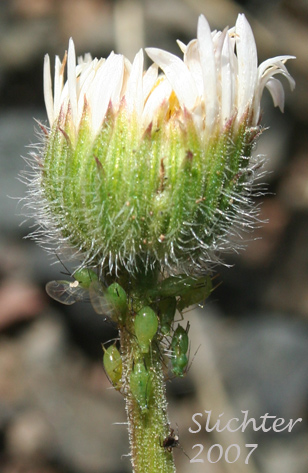 The photo at right shows a close-up view of the involucre of cutleaf flebane (var. compositus) as seen at Hat Pt. in the Hells Canyon National Recreation Area.......June 28, 2007. Note the numerous spreading hairs arising from the involucral bracts.
The photo at right shows a close-up view of the involucre of cutleaf flebane (var. compositus) as seen at Hat Pt. in the Hells Canyon National Recreation Area.......June 28, 2007. Note the numerous spreading hairs arising from the involucral bracts.
Cutleaf fleabane is an attractive wildflower suitable for the rock garden. It is a low growing wildflower with flower stems 5-25 cm high, arising from a basal mat of numerous branched, leafy stems. The herbage ranges from a dense covering of short hairs to glandular. Each leaf ranges from 2-7 cm long and is once to four times ternate. The divisions are are thinly to broadly linear. The leaves of the upper stems are linear or ternate.
The flower heads are solitary atop the flower stems. The disc flowers are yellow, frequently with or without ray flowers in the same population. The ray flowers are white, lavendar, or pink and range from 5-12 mm long. Cutleaf Fleabane flowers from May to August.
Cutleaf fleabane makes an attractive rock garden plant. Make sure that it is not crowded by taller plants, and give it good drainage.
Fernleaf /Cutleaf Daisy - Var. compositus: Plants of high elevation. Leaves generally three to four times ternate with very long, slender divisions.
Trifid Mountain Fleabane -Var. discoideus: Plants of high elevation. Leaves generally only once ternate with short, broad divisions. Flowers discoid or radiate.
Dwarf Mountain Fleabane - Var. glabratus: Plants of high elevation. Leaves generally twice to thrice ternate with segments broader rather than long and slender.
Cut-leaved daisy may be found in open, rocky or sandy places from the lowlands to well above timberline.
Cut-leaved daisy may be found from Alaska east to Greenland, south to South Dakota, northern Colorado and California, and westward to the Cascade summits of Washington and Oregon.